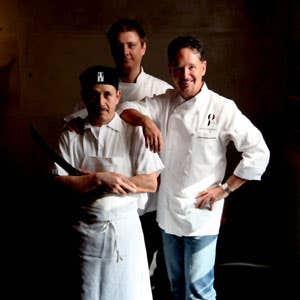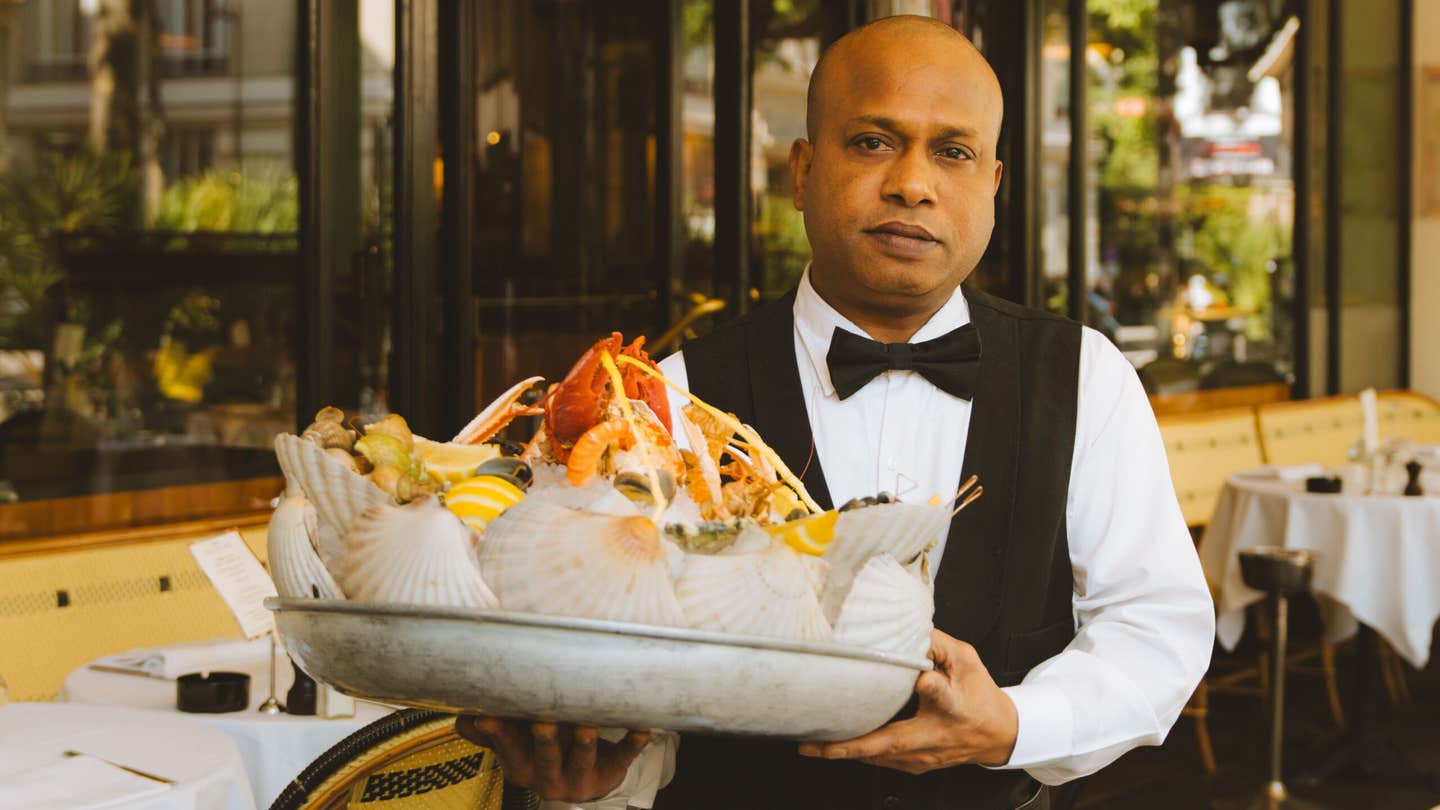
To anyone familiar with Southwestern cuisine today, it almost sounds like a cliche: hickory-grilled catfish served atop a pool of smoked-pepper butter sauce with a black bean relish in a tomatillo husk. But back in 1984, when the chef Stephan Pyles introduced that dish at Routh Street Cafe, in Dallas, it came as nothing less than an epiphany. Here was catfish, previously the province of small-town diners and ramshackle roadhouses, given star billing on an expensive, fixed-price menu. Here were black beans and tomatillo, foods I'd seldom seen outside Tex-Mex cantinas, presented with the sort of panache normally reserved for French nouvelle cuisine. I was a restaurant critic in Dallas at the time and instantly became enamored with what Pyles and a few other chefs were doing with ingredients that had long been a part of everyday life in the ranchlands and high deserts of the American Southwest: hickory and mesquite, chiles, beans, Gulf Coast fish, and so on. Such was my enthusiasm that one skeptical writer at Texas Monthly accused me of wearing "red chile-tinted glasses". I even wrote a three-part series for the Dallas Times Herald called "The Dawn of a New Cuisine".
That claim may sound grandiose today, given that foods like chipotle, cilantro, and fajitas have become as much a part of the national vernacular as ketchup, but what Stephan Pyles and his cohorts accomplished in the early 1980s—namely, the elevation of those traditional Southwestern ingredients to the realm of haute cuisine—was revolutionary. It was also in keeping with the times. In the early 1980s America was going through a wild culinary adolescence. Up to that moment, upscale dining in most parts of the country had meant staid, Continental-style fare: shrimp cocktail, hearts of palm salad, chateaubriand with bearnaise sauce. Suddenly, chefs were finding inspiration closer to home. On the West Coast, Wolfgang Puck and Alice Waters were combining classical French technique and fresh local ingredients in a newly minted California cuisine. In Texas, the impulse was similar, but the ingredients and traditions put chefs there on a path all their own; if Waters revered baby greens and garlic scapes, Pyles and company went for big flavors and bold pairings of a kind that would become emblematic of the era, and of Texas.
The Texans who led the way, a group that came to be called the Gang of Five, went on to become some of the Southwest's brightest culinary stars: the cook and food writer Anne Greer McCann, whose book Cuisine of the American Southwest is the movement's official manual; Dean Fearing, who was chef at the vaunted Mansion on Turtle Creek, in Dallas, for 21 years; Avner Samuel, the Mansion chef before Fearing; Robert Del Grande of Cafe Annie, a Houston institution; and Pyles. Twenty-five years ago, they were all audacious young chefs on the cusp of a culinary trend that would eventually reverberate across America. But it was Pyles, the group's only native Texan, who would remain closer than any of them to the roots of the Southwest's cooking traditions. What's more, over the past 25 years, even as Southwestern cuisine has spread far beyond the region and become cliched in many quarters, Pyles has continually rethought and refined his approach to come up with something fresh and new.
A fifth-generation Texan, Stephan Pyles, now 57, grew up in Big Spring, a hot, dusty town in the Panhandle, where he worked in the kitchen of the truck stop his parents owned. He left home at the age of 18 to study music at East Texas State University before doing stints at a few small restaurants in Dallas. In 1981, he was hired as a chef's assistant at the Great Chefs of France cooking school, a four-weekend program held annually on the grounds of the Robert Mondavi Winery, in California's Napa Valley, where he returned to work each year for several more years. There, Pyles became fully versed in French technique under the tutelage of such visiting masters as Michel Guerard, Pierre Troisgros, and Georges Blanc.
When he opened Routh Street Cafe with his business partner John Dayton in 1983, Pyles made clear right away that he was going to do things differently. In a sleek, minimalist space—with glazed pink and gray walls and exposed steel ducts—he put out food that told patrons they were in the hands of a classically trained chef but still firmly planted on Texas soil. Pyles infused his demi-glace with the earthy essence of ancho chiles; he piqued his beurre blanc with smoked tomatoes and garlic; he offered a lobster enchilada that was essentially stuffed with lobster a l'americaine (lobster cooked with cream, tomatoes, garlic, shallots, and herbs) emboldened by serrano chiles. Pyles served that last dish in a tortilla folded into a diamond and drizzled artfully with red pepper-infused creme fraiche. It was a sophisticated presentation that would later be copied from coast to coast, as would the blue cornmeal crust he used for a version of his catfish that was plated with a sauce of golden tomato and Mexican mint marigold, an herb otherwise known as Texas tarragon.
The Southwest, and especially Texas, was taking its rightful place in the country's culinary firmament—an ascent helped along, for better or worse, by a little cultural phenomenon called Dallas, the hugely popular television show that ran from 1978 to 1991. Cajun-style blackened catfish was shoved aside as the trend du jour, and chefs all over the country started to add cilantro pesto to chicken breasts and smoked-tomato salsa to grilled steaks. Just about anything that could be wrapped in a tortilla was ripe for reinvention. By the mid-1990s, the preoccupation with Southwestern cuisine among chefs at high-end restaurants was beginning to diminish, much as the Cajun fad had before it, but Pyles stuck to it and even managed to breathe bold new life into the cuisine he helped define.
For Pyles, Southwestern cooking was the opposite of a fad. Although many of his contemporaries had since roamed off into other culinary realms, he found himself wanting to dive even more deeply into the flavors and imagery and lore of his home region. "By the end [at Routh Street Cafe] I was doing food that didn't fit with the refined decor," he says. "I wanted to bust out into bigger flavors." He and Dayton opened a more casual offshoot, Baby Routh, along with two restaurants in Minneapolis, Dayton's hometown, but after Routh Street closed, in 1993, the partnership dissolved.
So, in 1994, Pyles opened Star Canyon, a place that positively shouted Texas, right down to the terra-cotta tiles, barbed-wire accents, and open hearth, which was straight out of the mammoth ranches of the Old West. Pyles unleashed his inner cowboy, creating one of his signature entrees: the cowboy rib eye, a 24-ounce bone-in mesquite-grilled steak, topped with a Medusa's tangle of crisp-fried, chile-dusted onion rings. He also invented the tamale tart: a soft shell of corn masa, flavored with red bell peppers and ancho chiles, filled with a savory roasted garlic custard; on top of it all sits a mound of crabmeat infused with the sting of serrano chiles. Bold tasting and long on swagger, it telegraphs Texas's bounty. It was here, too, that he created Heaven and Hell, a dessert of truly Texan proportions composed of alternating layers of angel's food and devil's food cake separated by creamy peanut butter mousse and enrobed in chocolate ganache.
Star Canyon was a hit, and it led to a number of lucrative spin-offs. But in 2000 Pyles stunned the restaurant world by walking away from the industry altogether. "I was burned out," he says. "I needed some personal time." Over the course of the next five years, he traveled to Spain, Morocco, Turkey, and Greece and spent extended sojourns in South America.
What Pyles did after he returned to Dallas sparked an evolutionary leap for Southwestern cuisine, which until then had mostly been an assemblage of local ingredients harnessed to classical French models of cooking. Pyles's travels had given him a visceral sense of the many subtle organic connections linking Texas foods with the far-flung cuisines of the world. While Southwestern-style cooking had become tired and one-dimensional in other parts of the country, Pyles was poised to reveal its hidden depths.
When he jumped back into the fray in 2005, with a new Dallas restaurant that bore his name, his food reflected the cooking traditions of not only Texas, the Southwest, and Mexico but also South America and the Mediterranean, among other regions. He called his updated approach New Millennium Southwestern—a name that jibed with the trend toward fusion food that was prominent at the time (and one he repeats now with some embarrassment). And yet, what Pyles gave diners at his new, namesake restaurant amounted to much more than facile mash-ups of disparate flavors and styles; his menu reflected the maturity of a confident chef who could recognize the complementary aspects of multiple cuisines.
At Stephan Pyles, there's little question that we have, indeed, entered a new millennium. In the center of the huge space is a glass-enclosed, 1,500-square-foot kitchen—Pyles calls it the jewel box—that can be seen from every corner of the dining room. The main attractions of that kitchen are a wood-burning grill and a rotisserie; they are the forges for the bold, smoky flavors that have become a hallmark of the restaurant. The menu features seafood dishes that evoke Pyles's South American travels, including a ceviche of lobster with roasted vanilla-scented fennel and kampachi with agave nectar and guanabana. One evening I had a gazpacho made with crunchy almonds and frozen grapes; an alternate version of that dish had smoked tomatoes and sweet, earthy beets. On another visit my pork osso buco braised with guajillo chiles arrived alongside a naturally sweet butternut squash polenta, while a friend's beef tenderloin came with sweet potato chilaquiles garnished with a mole of pineapple, spices, herbs, nuts, ground tortillas, and four types of chile. Was this pan-South American? Tex-Latin fusion? Eventually I forgot all about trying to assign a name to the kind of cuisine Pyles was conceiving. Whatever it was, it was brilliant.
Stephan Pyles the restaurant is still going strong, but Stephan Pyles the chef is restless again. He told me recently that he thinks he's strayed too far from his roots. "We're not utilizing a lot of the ingredients I love," he said. So, later this year, if all goes as planned, he'll channel his more globally inclined impulses into a new restaurant called Samar, where he intends to create small plates reflecting the cuisines of India, the eastern Mediterranean, and Spain. That way, he can rededicate the menu at Stephan Pyles to what he calls "more refined Southwestern": a pared-down, elegant cuisine that's shorn of some of the genre's more over-the-top traits—a return to the fundamentals.
He may even create another restaurant like Star Canyon in a smaller format. He's open to other possibilities as well, but he wants never to lose sight of why he got into the business in the first place and why, years later, he went back to it: the sheer pleasure of cooking. Still, he's somewhat perplexed about how to categorize this new style he's cultivating. "I do think New Millennium Southwestern sounds silly," he admits, "but I don't know what to call it."
Keep Reading
Continue to Next Story










